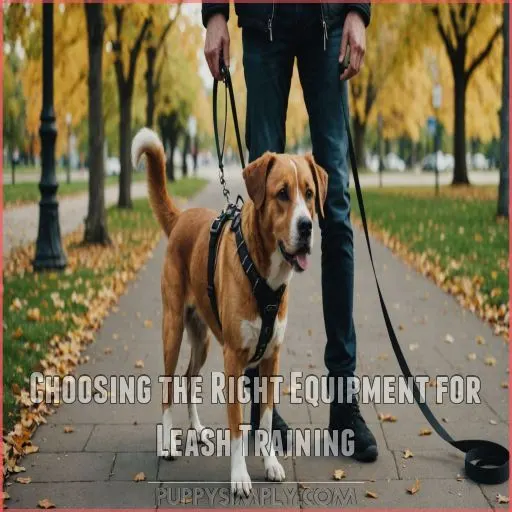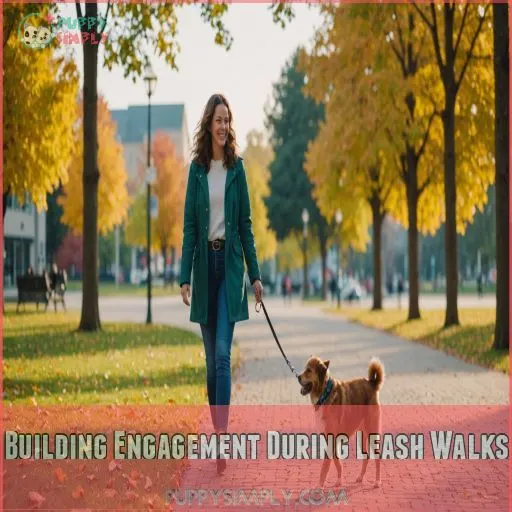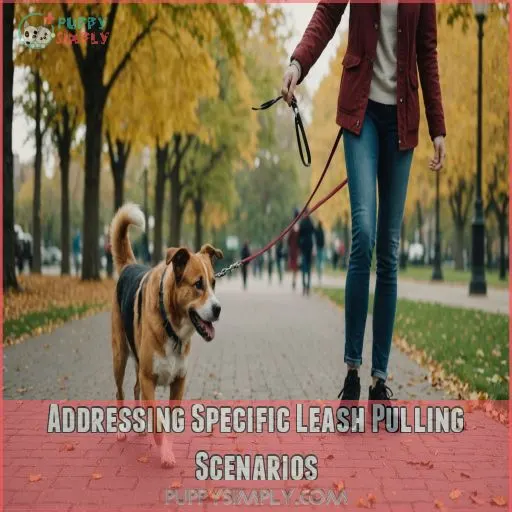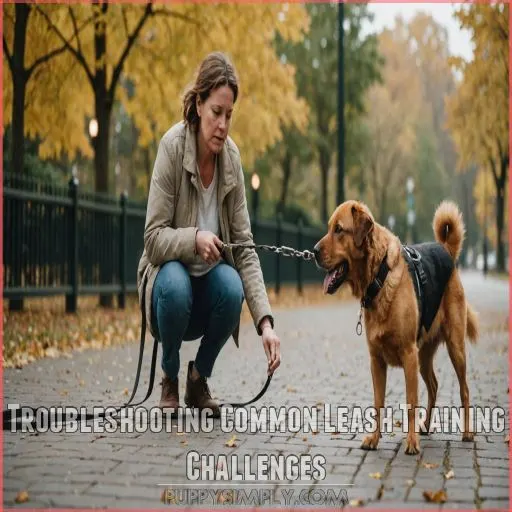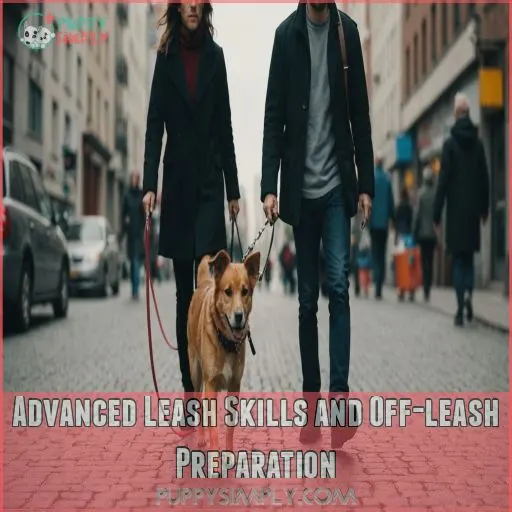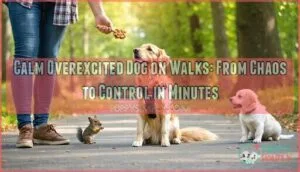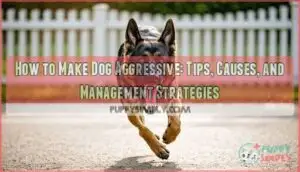This site is supported by our readers. We may earn a commission, at no cost to you, if you purchase through links.

Start by stopping in your tracks when your furry friend pulls, only moving forward when the leash is loose. Reward good behavior with treats and praise, gradually reducing treat dependency over time. Mix it up with the "turn around" technique to keep your dog guessing and focused on you.
Remember, patience is your secret weapon – Rome wasn’t built in a day, and neither is perfect leash etiquette. Stick with it, and you’ll be strolling in harmony before you know it!
Table Of Contents
- Key Takeaways
- Positive Reinforcement Techniques for Leash Training
- Stop and Go Method for Leash Pulling
- Turn Around Technique to Discourage Pulling
- Choosing the Right Equipment for Leash Training
- Building Engagement During Leash Walks
- Addressing Specific Leash Pulling Scenarios
- Establishing a Consistent Leash Walking Routine
- Leash Training for Different Dog Ages
- Troubleshooting Common Leash Training Challenges
- Advanced Leash Skills and Off-leash Preparation
- Frequently Asked Questions (FAQs)
- How to train a dog to stop pulling on a leash?
- What is the best tool to stop a dog from pulling?
- What is the command for a dog to stop pulling?
- How to stop a strong dog from pulling and lunging?
- How long does it take to stop leash pulling?
- Can leash pulling cause health issues for dogs?
- Should I use treats during every leash training session?
- How do I leash train multiple dogs simultaneously?
- Are certain breeds more prone to leash pulling?
- Conclusion
Key Takeaways
- You’re not alone in this tug-of-war! Consistency and positive reinforcement are your secret weapons. Stop when your pup pulls, only moving forward when the leash is loose. It’s like hitting the pause button on their adventure – they’ll quickly learn that pulling gets them nowhere fast.
- Treats are your training rocket fuel, but don’t forget to mix it up! Use a variety of high-value goodies and pair them with enthusiastic praise. Gradually reduce treat dependency as your furry friend becomes a loose-leash pro. Soon, a "good dog!" will be music to their ears.
- Turn walks into a game of "follow the leader" with the turn-around technique. When your pup pulls, surprise them by changing direction. It keeps them on their toes and focused on you, transforming your strolls from chaos to choreography.
- Remember, Rome wasn’t built in a day, and neither is perfect leash etiquette. Be patient and celebrate small victories. With consistent practice, you’ll go from feeling like a human kite to enjoying peaceful walks with your four-legged friend in no time.
Positive Reinforcement Techniques for Leash Training
You’re about to discover the power of positive reinforcement in leash training your pup learn about positive reinforcement.
By using treats, praise, and consistent cues, you’ll transform those chaotic walks into enjoyable strolls – no more feeling like you’re in a tug-of-war championship!
Using Treats and Praise to Reward Good Behavior
You’ve got three powerful tools in your leash-training toolkit: treats, praise, and perfect timing.
Use a variety of high-value goodies to keep your pup motivated and mix up your verbal encouragement for maximum tail-wagging impact.
Timing and Consistency in Reinforcement
Mastering the art of perfect timing is super important.
Reward your pup instantly when they walk nicely.
Consistency is key—stick to your training plan like glue for faster, lasting results.
Gradually Reducing Treat Dependency
Once your pup’s getting the hang of it, start easing up on the treats.
Mix in praise and pets alongside snacks.
Gradually space out rewards, keeping your furry friend guessing and engaged.
Verbal Cues and Hand Signals for Walking
Choose a clear word or phrase as your walking cue. Pair it with a consistent hand signal. Your dog will quickly learn to associate these cues with loose-leash walking.
Stop and Go Method for Leash Pulling
You’re about to discover a simple yet effective method to curb your dog’s leash-pulling habit.
The Stop and Go technique is a game-changer that’ll transform your walks from a tug-of-war into a pleasant stroll, using your pup’s natural curiosity to your advantage.
Stopping Immediately When the Dog Pulls
You’ve mastered positive reinforcement, now let’s tackle the pull.
When your furry friend lunges forward, stop in your tracks.
This simple act speaks volumes:
- It’s like hitting the pause button
- Your pup learns pulling doesn’t work
- You’re in control, not your dog’s nose
Waiting for the Dog to Return or Loosen Leash
After stopping, stand your ground. Keep the leash tight, but don’t pull back. Watch for signs your pup’s getting antsy. Patience is key—they’ll eventually look back or loosen up.
Rewarding the Dog for Returning to Your Side
When your furry friend returns to your side, it’s treat time! Here’s your four-step reward plan:
- Immediate praise
- Quick treat delivery
- Gentle pat or scratch
- Enthusiastic "good dog!
Resuming Walk Only When Leash is Slack
Consistently resume your walk only when the leash is slack. This teaches your pup that a loose leash is their ticket to adventure. It’s a win-win: you stroll, they learn!
Turn Around Technique to Discourage Pulling
If your dog’s pulling you around like a sled dog, it’s time to try the turn-around technique.
This simple yet effective method teaches your pup that pulling leads to the opposite of what they want, making walks more enjoyable for both of you.
Changing Direction When the Dog Pulls
You’ve mastered the stop-and-go technique, but your pup’s still pulling? Time to switch it up! The turn-around method is your secret weapon. Here’s how it works:
- Surprise your dog by changing direction
- Use a cheerful voice to encourage following
- Reward generously when they catch up
This keeps your furry friend on their toes, transforming walks into an exciting game of "follow the leader." Your dog’s natural curiosity will have them keenly anticipating your next move, making leash-pulling a thing of the past.
Teaching the Dog to Pay Attention to Your Movements
Now that you’ve changed direction, it’s time to become a canine mind-reader! Your pup needs to tune into your every move like you’re the star of their favorite show.
Reinforcing the Importance of Following Your Lead
By reinforcing your leadership, you’ll create a harmonious walking experience. Your dog will learn to follow your cues readily.
- Use confident body language
- Maintain consistent walking pace
- Reward attentiveness with praise
Dealing With Repeated Pulling in New Directions
When your pup keeps pulling, don’t throw in the towel! Turn on your heels and walk the opposite way. Repeat as needed, rewarding each time they follow your lead.
Choosing the Right Equipment for Leash Training
Choosing the right gear for your leash-training journey can make all the difference in taming your pup’s inner sled dog.
Let’s explore the best leashes, collars, and harnesses to turn your daily walks from a tug-of-war into a leisurely stroll.
Selecting an Appropriate Leash Length and Material
Choosing the right leash is important for successful training. You’ll want to think about:
- Durability for strong pullers
- Comfortable length (6-10 feet)
- Lightweight for easy handling
- Visible color for safety
Flat Collars Vs. Harnesses for Different Breeds
Consider your dog’s build and behavior when deciding between flat collars and harnesses.
Flat collars work well for calm breeds, while harnesses offer better control for strong pullers or brachycephalic dogs.
Avoiding Choke Chains and Prong Collars
Ditch those choke chains and prong collars! They’re old news and can harm your furry friend. Instead, embrace kinder alternatives that’ll make both you and your pup happier during walks.
Specialized No-pull Harnesses and Their Effectiveness
Now, let’s explore no-pull harnesses. They’re a game-changer for many pup parents! These harnesses work by redirecting your dog’s pulling force, making walks a breeze. But are they truly effective?
Building Engagement During Leash Walks
Want to transform your dog’s leash walks from a chore to a joy?
By making walks more engaging and exciting, you’ll curb leash-pulling and also strengthen your bond with your furry friend.
Making Walks Unpredictable and Exciting
Make your walks a thrilling adventure!
Surprise your pup with unexpected turns, new routes, and exciting pit stops.
You’ll keep them guessing and engaged, turning leash time into a fun-filled journey.
Incorporating Games and Training Exercises
Let’s spice up your walks with some playful training games! Hide-and-seek, fetch-and-release, or a quick round of tug-of-war can transform a routine stroll into an exciting adventure for your pup.
Using Environmental Rewards for Good Behavior
Beyond games, you can leverage your dog’s surroundings as rewards. When they walk nicely, allow them to sniff that intriguing lamppost or greet a friendly neighbor. It’s a win-win!
Balancing Structured Walking With Exploration Time
Imagine a happy medium: structured walks paired with sniff-filled adventures.
You’ll keep your pup engaged by mixing focused heel time with off-leash exploration in safe areas.
It’s the best of both worlds!
Addressing Specific Leash Pulling Scenarios
You’ve mastered the basics, but now it’s time to tackle those tricky leash-pulling scenarios that every dog owner faces.
Whether your pup goes bonkers at the sight of another dog or turns into a four-legged bulldozer when excited, we’ve some useful tips for common leash challenges.
Dealing With Pulling Towards Other Dogs
When your pup spots another dog, they might turn into a four-legged missile!
This behavior’s often rooted in fear or overexcitement.
Don’t worry – we’ve got strategies to keep Fido focused on you.
Managing Excitement-induced Pulling
Excitement can turn your pup into a furry rocket!
To curb that enthusiasm, start walks calmly.
Watch for those pre-launch signals and redirect their energy before liftoff.
Timing is everything with rewards!
Handling Fear or Anxiety-related Pulling
Got a scaredy-pup on your hands? Fear not! To tackle anxiety-driven pulling, start by identifying triggers.
Then, use treats and praise to create positive associations.
Gradually expose your furry friend to fear-inducing stimuli.
Leash Manners for Different Environments (urban Vs. Rural)
Urban or rural, your pup’s leash manners matter. In busy streets, keep ’em close with a shorter leash. Country walks? Let ’em roam a bit more. Adapt to your surroundings!
Establishing a Consistent Leash Walking Routine
Establishing a consistent leash walking routine is your ticket to stress-free strolls with your furry friend.
By setting clear expectations and creating a pre-walk ritual, you’ll transform your dog from a chaotic puller into a polite walking companion, making every outing a tail-wagging success.
Setting Clear Expectations for Walk Behavior
You’ve tackled specific scenarios, now let’s lay down the law for walks. Set clear rules: no pulling, stay close, and mind your manners. Your pup’ll thank you later!
Creating a Pre-walk Ritual to Set the Tone
Set the stage for a successful walk with a pre-walk ritual. It’ll get your pup in the right mindset and establish positive expectations.
- Leash-free practice indoors
- Quick mental stimulation game
- Calming exercises or massage
- Mood-boosting praise session
Maintaining Focus Throughout the Entire Walk
Countless distractions can derail your pup’s focus during walks.
Keep their attention by turning walk time into game time.
Mix in quick training exercises to prevent boredom and boost mental stimulation, like those found in mental stimulation sections.
Gradually Increasing Walk Duration and Difficulty
Once your dog’s mastered basic leash manners, it’s time to up the ante!
Start stretching those walks, mixing in new terrains, and throwing curveballs with distractions.
Your pup’s skills will skyrocket!
Leash Training for Different Dog Ages
You’re not alone if you’ve wondered whether leash training differs for puppies, adult dogs, and seniors.
Let’s explore age-specific techniques and breed considerations that’ll help you tailor your approach, making walks a breeze no matter your dog’s life stage.
Puppy-specific Leash Training Techniques
While puppies are excited to explore, their short attention spans require a gentle approach.
Start with brief, positive sessions using a lightweight harness.
Reward often and keep it fun—you’re building a lifelong walking buddy!
Adapting Methods for Adult Dogs With Ingrained Habits
Adult dogs with ingrained habits? Don’t fret! You can teach an old dog new tricks. Reframe their mindset by consistently rewarding good behavior. It’s all about patience and positive reinforcement.
Senior Dog Considerations in Leash Training
Training senior dogs requires a gentle touch. Your aging companion may face unique challenges, but with patience, you can teach old dogs new tricks!
- Adjust for decreased stamina
- Be mindful of joint pain
- Account for cognitive changes
- Embrace a slower pace
Breed-specific Challenges and Solutions
Different breeds present unique leash-training challenges. You’ll need specific strategies to address their specific traits. Here’s a quick guide to help you tackle common breed-specific issues:
| Breed Type | Challenge | Solution |
|---|---|---|
| Herding | Strong instinct to chase | Use "Look at Me" command |
| Terriers | High prey drive | Practice impulse control exercises |
| Large breeds | Powerful pulling | Employ no-pull harnesses |
| Scent hounds | Easily distracted by smells | Incorporate sniffing breaks |
Leash training can be challenging, depending on the dog’s breed.
Troubleshooting Common Leash Training Challenges
Even with the best techniques, you might encounter some hiccups in your leash training journey.
Let’s tackle common challenges like leash reactivity, easily distracted pups, high-energy dogs, and stubborn behavior to help you and your furry friend become sidewalk superstars.
Overcoming Leash Reactivity and Lunging
You’ve mastered age-specific training, but what about leash reactivity? It’s like your dog becomes a different creature! Let’s tackle this challenge head-on with some proven techniques to restore calm walks.
Dealing With Easily Distracted Dogs
Walking a distracted dog can feel like herding cats. To keep your pup focused:
- Use high-value treats
- Play focus games
- Vary your route
- Practice in low-distraction areas first
Managing High-energy Dogs During Walks
Everyone’s been there: your energetic pup turns walks into marathons!
Try dog park visits for pre-walk zoomies, then engage their mind with training games.
Short bursts of exercise can work wonders too.
Addressing Stubborn or Resistant Behavior
Why does your pup resist leash training? Stubbornness often stems from confusion or fear.
Stay patient, use positive reinforcement consistently, and consider a harness.
If you’re stuck, don’t hesitate to seek professional help.
Advanced Leash Skills and Off-leash Preparation
You’ve mastered the basics of leash training, but now it’s time to take your dog’s skills to the next level.
Advanced techniques will have your pup walking like a pro and prepare them for off-leash adventures.
Teaching Heel Position for Controlled Walking
You’ve tackled common challenges, now let’s elevate your game! Teaching your pup to heel isn’t just for show dogs. It’s your secret weapon for stress-free walks and off-leash adventures.
Incorporating Distance and Duration in Training
Start small and dream big! Gradually increase your walk length and distance goals. Set realistic time limits, then slowly extend them. Your pup’s endurance will grow alongside your bond.
Transitioning From On-leash to Off-leash Reliability
Moving to off-leash reliability is a delicate dance.
Begin in safe, enclosed spaces, gradually increasing distance and distractions.
Remember, your pup’s recall is their lifeline to freedom—make it irresistibly rewarding!
Proofing Leash Manners in Various Environments
Now that your pup’s leash skills are rock-solid, let’s take them for a spin in different settings. Practice makes perfect, so hit the dog park, city streets, and hiking trails!
Frequently Asked Questions (FAQs)
How to train a dog to stop pulling on a leash?
Tired of feeling like a kite in the wind?
You’ll tame that leash-pulling pup by stopping when they pull, rewarding loose-leash walking, and using positive reinforcement.
Mix up your walks to keep ’em engaged and attentive.
What is the best tool to stop a dog from pulling?
You’ll find the best tool isn’t a gadget, but positive reinforcement.
Use treats and praise to reward good walking behavior.
A well-fitted harness can help, but remember, it’s your consistent training that’ll truly stop the pulling.
What is the command for a dog to stop pulling?
Like a maestro directing an orchestra, you’ll guide your pup with a clear command.
Choose a phrase like "Let’s go" or "With me."
Use it consistently, pairing it with positive reinforcement to teach your dog loose-leash walking.
How to stop a strong dog from pulling and lunging?
Stop walking when your dog pulls or lunges. Stand still, keeping the leash tight. Wait for them to look back, then reward with praise and treats.
Consistency is key – never allow forward movement while pulling.
Practice makes perfect!
How long does it take to stop leash pulling?
Did you know 78% of dog owners struggle with leash pulling?
It’s a journey, not a sprint.
Consistency’s key, but expect 4-6 weeks of dedicated training.
Remember, your pup’s learning curve is unique – patience pays off!
Can leash pulling cause health issues for dogs?
Yes, leash pulling can harm your dog’s health.
You’re risking neck injuries, back problems, and even tracheal damage.
It’s not just annoying – it’s a real pain in the neck for your furry friend!
Should I use treats during every leash training session?
Picture treats as training rocket fuel!
You’ll want to start with a high-octane mix, gradually tapering off as your pup masters the leash.
Eventually, you’ll cruise on praise alone, but keep some treats handy for tricky situations.
How do I leash train multiple dogs simultaneously?
Start with individual training sessions for each dog, which is vital for preventing littermate syndrome.
Gradually introduce them together, using separate handlers initially.
Reward calm behavior and focus on you.
Gradually increase difficulty, always prioritizing safety and positive reinforcement.
It’s a juggling act, but you’ve got this!
Are certain breeds more prone to leash pulling?
Just as a fish takes to water, some breeds naturally pull more.
High-energy dogs like huskies and retrievers often tugging ahead.
But don’t fret! With consistent training, you can teach any breed loose-leash walking.
Conclusion
Practicing patience pays off when perfecting your pup’s promenade! Remember, mastering dog training tips for leash pulling takes time and consistency.
You’re now equipped with a toolkit of techniques to transform your walks from tug-of-war to teamwork.
Stay positive, keep treats handy, and celebrate small victories. With persistence, you’ll soon be strolling in sync, enjoying peaceful walks together.
So leash up, step out, and savor the journey of building a stronger bond with your four-legged friend. Happy trails await!




